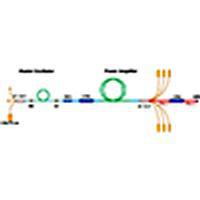当前位置:
X-MOL 学术
›
Photonics Res.
›
论文详情
Our official English website, www.x-mol.net, welcomes your
feedback! (Note: you will need to create a separate account there.)
Experimental study of mode distortion induced by stimulated Raman scattering in high power fiber amplifiers
Photonics Research ( IF 6.6 ) Pub Date : 2020-04-01 , DOI: 10.1364/prj.383551 Qiuhui Chu , Qiang Shu , Zeng Chen , Fengyun Li , Donglin Yan , Chao Guo , Honghuan Lin , Jianjun Wang , Feng Jing , Chuanxiang Tang , Rumao Tao
Photonics Research ( IF 6.6 ) Pub Date : 2020-04-01 , DOI: 10.1364/prj.383551 Qiuhui Chu , Qiang Shu , Zeng Chen , Fengyun Li , Donglin Yan , Chao Guo , Honghuan Lin , Jianjun Wang , Feng Jing , Chuanxiang Tang , Rumao Tao

|
The experimental investigation of mode distortion induced by stimulated Raman scattering (SRS) in a high-power fiber amplifier, which includes the evolutions of optical spectra, spatial beam profiles, and time-frequency characteristics, has been carried out in detail. Temporal-frequency characteristics have been studied for the first time, to the best of our knowledge, by using a low-speed camera and high-speed photodiode traces, which revealed that temporal-frequency characteristics of SRS-induced mode distortion are different from traditional dynamic mode instability (MI). The experimental results show that the output beam profile remains stable before the mode distortion occurs and fluctuates obviously after the onset of SRS-induced MI but on a time scale of seconds, which is much lower than that of Yb-gain-induced MI featuring millisecond-level beam profile fluctuation. It also shows that the mode distortion became measurable in company with the onset of inter-mode four-wave mixing (IM-FWM) when the ratio of Raman light reaches 3%; further, the beam quality factor M2 degrades gradually from 1.4 to 2.1 as the ratio of Raman light increases. The mode distortion is accompanied by an obvious temperature increase of the output passive fiber, which further confirms that the mode distortion originates from SRS. The cause of the mode distortion induced by SRS has been explained in the context of core-pumped SRS effect, and the investigation on the accompanying IM-FWM effect indicates that the main content of the SRS-induced high-order mode is the LP21 mode.
中文翻译:

高功率光纤放大器中受激拉曼散射引起的模式畸变的实验研究
对高功率光纤放大器中受激拉曼散射 (SRS) 引起的模式失真进行了详细的实验研究,包括光谱、空间光束轮廓和时频特性的演变。据我们所知,首次通过使用低速相机和高速光电二极管迹线研究了时频特性,结果表明 SRS 引起的模式失真的时频特性不同于传统的动态模式不稳定性 (MI)。实验结果表明,输出光束轮廓在模式畸变发生前保持稳定,在 SRS 诱发 MI 发生后波动明显,但时间尺度为秒,这远低于具有毫秒级光束轮廓波动的 Yb 增益诱导的 MI。它还表明,当拉曼光的比率达到 3% 时,随着模式间四波混合 (IM-FWM) 的开始,模式失真变得可测量;此外,随着拉曼光比的增加,光束质量因子 M2 从 1.4 逐渐降低到 2.1。模式畸变伴随着输出无源光纤的明显温度升高,进一步证实了模式畸变源于SRS。SRS引起的模式失真的原因已经在核心泵浦SRS效应的背景下进行了解释,对伴随的IM-FWM效应的调查表明,SRS引起的高阶模式的主要内容是LP21模式. 它还表明,当拉曼光的比率达到 3% 时,随着模式间四波混合 (IM-FWM) 的开始,模式失真变得可测量;此外,随着拉曼光比的增加,光束质量因子 M2 从 1.4 逐渐降低到 2.1。模式畸变伴随着输出无源光纤的明显温度升高,进一步证实了模式畸变源于SRS。SRS引起的模式失真的原因已经在核心泵浦SRS效应的背景下进行了解释,对伴随的IM-FWM效应的调查表明,SRS引起的高阶模式的主要内容是LP21模式. 它还表明,当拉曼光的比率达到 3% 时,随着模式间四波混合 (IM-FWM) 的开始,模式失真变得可测量;此外,随着拉曼光比率的增加,光束质量因子 M2 从 1.4 逐渐降低到 2.1。模式畸变伴随着输出无源光纤的明显温度升高,进一步证实了模式畸变源于SRS。SRS引起的模式失真的原因已经在核心泵浦SRS效应的背景下进行了解释,对伴随的IM-FWM效应的调查表明,SRS引起的高阶模式的主要内容是LP21模式. 随着拉曼光比的增加,光束质量因子 M2 从 1.4 逐渐降低到 2.1。模式畸变伴随着输出无源光纤的明显温度升高,进一步证实了模式畸变源于SRS。SRS引起的模式失真的原因已经在核心泵浦SRS效应的背景下进行了解释,对伴随的IM-FWM效应的调查表明,SRS引起的高阶模式的主要内容是LP21模式. 随着拉曼光比的增加,光束质量因子 M2 从 1.4 逐渐降低到 2.1。模式畸变伴随着输出无源光纤的明显温度升高,进一步证实了模式畸变源于SRS。SRS引起的模式失真的原因已经在核心泵浦SRS效应的背景下进行了解释,对伴随的IM-FWM效应的调查表明,SRS引起的高阶模式的主要内容是LP21模式.
更新日期:2020-04-01
中文翻译:

高功率光纤放大器中受激拉曼散射引起的模式畸变的实验研究
对高功率光纤放大器中受激拉曼散射 (SRS) 引起的模式失真进行了详细的实验研究,包括光谱、空间光束轮廓和时频特性的演变。据我们所知,首次通过使用低速相机和高速光电二极管迹线研究了时频特性,结果表明 SRS 引起的模式失真的时频特性不同于传统的动态模式不稳定性 (MI)。实验结果表明,输出光束轮廓在模式畸变发生前保持稳定,在 SRS 诱发 MI 发生后波动明显,但时间尺度为秒,这远低于具有毫秒级光束轮廓波动的 Yb 增益诱导的 MI。它还表明,当拉曼光的比率达到 3% 时,随着模式间四波混合 (IM-FWM) 的开始,模式失真变得可测量;此外,随着拉曼光比的增加,光束质量因子 M2 从 1.4 逐渐降低到 2.1。模式畸变伴随着输出无源光纤的明显温度升高,进一步证实了模式畸变源于SRS。SRS引起的模式失真的原因已经在核心泵浦SRS效应的背景下进行了解释,对伴随的IM-FWM效应的调查表明,SRS引起的高阶模式的主要内容是LP21模式. 它还表明,当拉曼光的比率达到 3% 时,随着模式间四波混合 (IM-FWM) 的开始,模式失真变得可测量;此外,随着拉曼光比的增加,光束质量因子 M2 从 1.4 逐渐降低到 2.1。模式畸变伴随着输出无源光纤的明显温度升高,进一步证实了模式畸变源于SRS。SRS引起的模式失真的原因已经在核心泵浦SRS效应的背景下进行了解释,对伴随的IM-FWM效应的调查表明,SRS引起的高阶模式的主要内容是LP21模式. 它还表明,当拉曼光的比率达到 3% 时,随着模式间四波混合 (IM-FWM) 的开始,模式失真变得可测量;此外,随着拉曼光比率的增加,光束质量因子 M2 从 1.4 逐渐降低到 2.1。模式畸变伴随着输出无源光纤的明显温度升高,进一步证实了模式畸变源于SRS。SRS引起的模式失真的原因已经在核心泵浦SRS效应的背景下进行了解释,对伴随的IM-FWM效应的调查表明,SRS引起的高阶模式的主要内容是LP21模式. 随着拉曼光比的增加,光束质量因子 M2 从 1.4 逐渐降低到 2.1。模式畸变伴随着输出无源光纤的明显温度升高,进一步证实了模式畸变源于SRS。SRS引起的模式失真的原因已经在核心泵浦SRS效应的背景下进行了解释,对伴随的IM-FWM效应的调查表明,SRS引起的高阶模式的主要内容是LP21模式. 随着拉曼光比的增加,光束质量因子 M2 从 1.4 逐渐降低到 2.1。模式畸变伴随着输出无源光纤的明显温度升高,进一步证实了模式畸变源于SRS。SRS引起的模式失真的原因已经在核心泵浦SRS效应的背景下进行了解释,对伴随的IM-FWM效应的调查表明,SRS引起的高阶模式的主要内容是LP21模式.











































 京公网安备 11010802027423号
京公网安备 11010802027423号